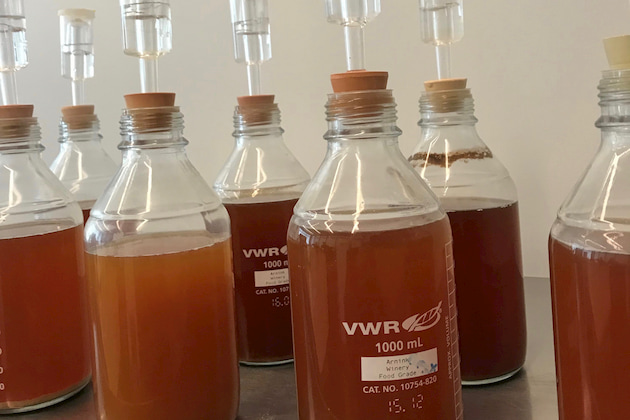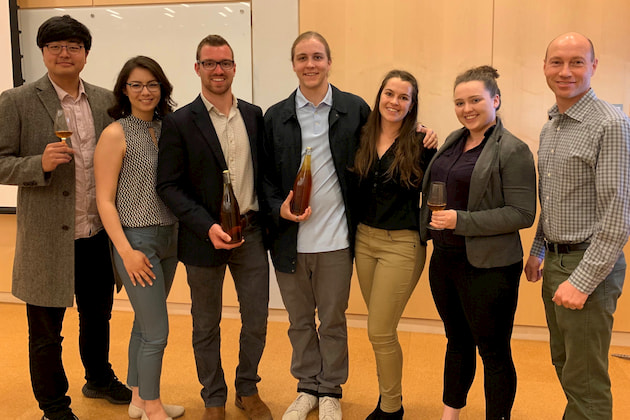Cornell Corner
Making maple wine can be a new way to profits
'Tricky' process can pay off with patience and persistence
By AARON WIGHTMAN, CORNELL MAPLE PROGRAM EXTENSION ASSOCIATE | AUGUST 13, 2019
VAN ETTEN, N.Y.—Maple syrup can be diluted and fermented to create a pleasant, full-bodied wine with elegant structure and great maple character.
However, without proper materials and technique, it is easy to make a poor quality wine that is bitter, astringent or sickly sweet.
This winter, the Cornell Maple Program worked with undergraduates at Cornell University to create guidelines for high-quality maple wine production.
Traditional wines are created through the fermentation of grape juice sugars by specialized yeasts. This ancient industry has seen a surge in growth in recent decades.
The New York State wine industry alone now generates over $4.5 billion in annual economic activity. An increased interest in domestic wines creates an opportunity for non-traditional wines produced with alternative sugars.
With maple wine, maple producers can tap this lucrative and expanding market.
Maple wine is not new, but for a variety of reasons it has not gained traction in the marketplace as a desirable, value-added maple product. One reason is the technical challenge of creating a good quality maple wine.
To overcome this obstacle, the Cornell Maple Program teamed up with six undergraduate students in the Department of Food Science to create a maple wine recipe.
The goal was to make a distinctive wine with maple syrup as the only sugar source, strong notes of maple in the flavor profile, and a good balance of tannins and acidity to create a complex structure.
The team began with a number of test fermentations using different dilution rates, yeast strains and yeast nutrients to identify the best fermentation method.
In the fermentation process, yeast doesn’t just convert sugar into alcohol. They also produce other by-products that dramatically influence flavor. Different yeast strains react to the stresses of a dynamic fermentation environment in different ways.
As a result, these trials yielded a wide variety of flavors, many of them favorable.
Identifying the most favorable alcohol content (alcohol by volume or ABV) and residual sugar content was the next challenge. According to federal guidelines, the acceptable ABV for table wine is 7 percent to 14 percent.
Alcohol content enhances flavor, but can add an undesirable burn to the sensory profile if too high or not balanced by other flavors. Residual sugar content varies widely by wine style, from bone-dry reds with less than 1 percent to ports and ice wines with more than 20 percent.
In keeping with the image of maple as a sweet treat without overwhelming the palate, a delicately-sweet style on par with a Riesling was targeted.
These ABV and residual sugar metrics were met by adjusting the dilution rate and arresting fermentation at the appropriate time by chilling and killing the yeast with potassium metabisulfite.
For the purposes of this project, a sensory analysis was conducted to choose the yeast strain that produced the best flavor. The team then focused on amendments to improve the flavor profile using acid and tannin additives.
The final formulation utilizes a vigorous strain of Saccharomyces cerevisiae yeast, tartaric acid and vanilla oak tannins to create a balanced, drinkable wine with 14 percent alcohol and 1 percent residual sugar.
Initial taste tests have garnered positive reviews.
A wine tasting expert in the Cornell Enology and Viticulture Program compared the quality to that of an expensive Madeira.
In fact, with a slight formula alteration, this wine could be crafted with higher alcohol and residual sugar to create a true, high-value dessert wine.
Many who sampled the wine described it as “delicious” and “drinkable.” Possible pairings include a wide variety of artisanal cheeses including sharp cheddar, chevre, buttery brie and strong blues.
Bottled in clear glass, the wine presents an attractive golden amber hue.
Another barrier to the production and sale of maple wine is the regulatory environment surrounding alcohol. Compliance through several state and federal agencies is required creating a potentially confusing array of licenses and permits.
To resolve this issue, the Cornell Maple Team again paired with Food Science students to develop clear guidance describing the regulatory and practical requirements for maple wine production and sale in New York State.
A Farm Winery License, obtained through the NYS Liquor Authority, is specifically tailored to small facilities producing specialty wines, and is a good option for maple wine production.
Under this license, production is limited to 250,000 gallons annually, but the licensing requirements are less stringent than those for a larger scale winery.
The Farm Winery License further mandates that the wine is made exclusively from NYS grown agricultural products. Compliance is also required through the federal Alcohol and Tobacco Tax and Trade Bureau (TTB) and the FDA.
These technical and legal guidelines for the production and sale of maple wine are detailed in the forthcoming publication, Maple Wine Methods and Materials for NY State Maple Syrup Producers, which will be made available at www.cornellmaple.com.


































